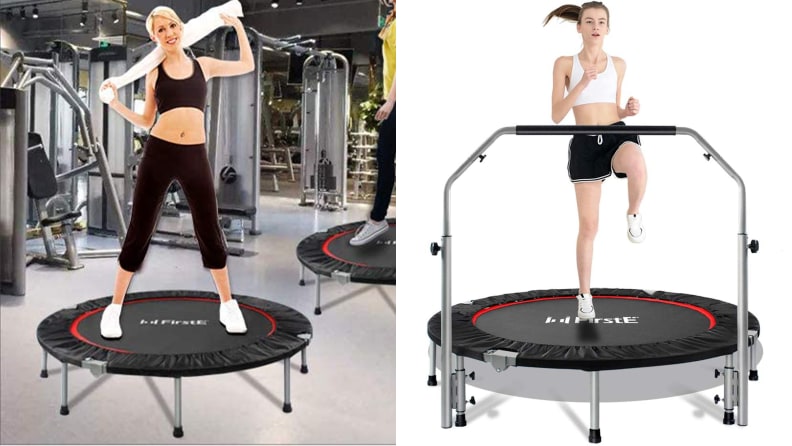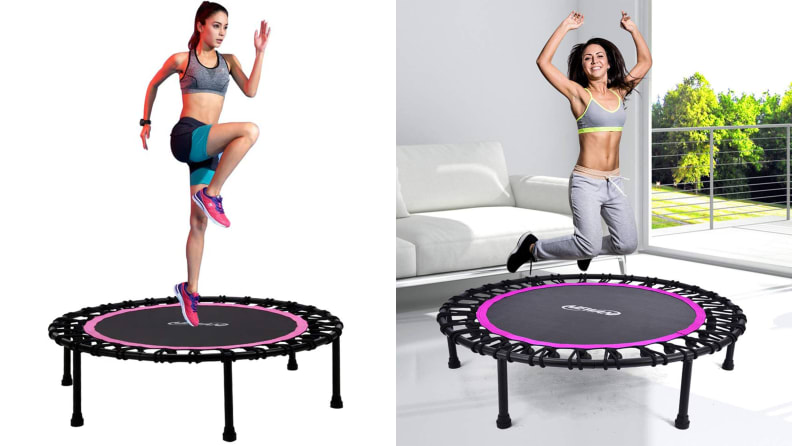Jump into a new fitness routine with a mini trampoline
A rebounder could be the key to enjoying exercise.
Products are chosen independently by our editors. Purchases made through our links may earn us a commission.
Between jump ropes and hula hoops, nostalgic workout gear is making a comeback. Another trending piece of gear that could bring you straight back to childhood? Mini trampolines. Also called “rebounders,” these bouncy surfaces offer a great way to gain strength, improve cardiovascular health, and develop balance, all while putting a smile on your face.
For those who loved jumping games like hopscotch or double-dutch as a kid, a rebounder workout could feel easier—or at least more fun—than other forms of aerobic exercise. If you're looking to bounce your way to better fitness, here's what you should know about mini trampolines.
What are mini trampolines?
These individual-sized jumping surfaces are designed for exercise. They're typically between 3 and 4 feet in diameter and often less than a foot high, which is fairly low to the ground compared to trampolines you'd set up in the backyard. The net surface, called the mat, is usually made of durable but semi-flexible material like nylon to withstand vigorous jumps by adult-sized humans. Rebounders also have either bungee cords or springs attaching the mat to the rim to create the bouncy sensation—there isn't much of a difference in feel between bungee cords and springs, but bungees may be quieter. Some rebounders also feature a hand rail for safety, which can be helpful for beginners.
To exercise with a mini trampoline, you can just bounce up and down to get some movement in or follow a specific rebounder workout available on YouTube or some workout apps like Obé. These often include variations like crossing the legs in and out, twisting from side to side, and single-leg hops, often done while moving the arms at the same time to engage the whole body. Many workouts last between 10 and 30 minutes.
Benefits of working out with a mini trampoline
Unsurprisingly, all that bouncing gets your heart rate up. In a small study from the American Council on Exercise (ACE), participants of a 20-minute trampoline class saw their average heart rate reach 145 beats per minute, or around 80% of their maximum heart rate. Target heart rate for moderate to vigorous exercise is 50% to 85% of maximum heart rate, according to the American Heart Association, so trampolining falls on the higher end of the scale.
All the data ACE collected indicates that rebounding is a moderately to vigorously intense exercise, but study participants reported feeling only light to moderate intensity during the workout. This could be because participants enjoyed using the trampolines, so the exercise didn’t feel as tiring. ACE also found the activity burns quite a few calories. Men burned an average of 12.4 calories per minute and women burned an average of 9.4 calories per minute, on par with running at a pace of 6 miles per hour (a 10-minute mile) or biking at a pace of 14 miles per hour.
In addition to the cardio benefits, rebounding could be a good workout option for those looking to keep pressure off their joints. “It's low impact, but high intensity,” says Aly Giampolo, trainer and co-founder of The Ness, a trampoline workout studio based in New York City. “When you bounce, your heart and muscles work without strain on the joints because the trampoline absorbs the impact of your landing.”
Bouncing on a rebounder may also be good for balance and stability, two crucial aspects of overall fitness. One study found that elderly participants who followed a 14-week mini-trampoline exercise program were 35% better at regaining balance from a forward fall.
How to stay safe when using a mini trampoline
As with any exercise gear, it's important to follow specific safety protocols. Before buying, consider the manufacturer's weight limit and if any users might exceed it. Place the equipment on a flat, non-slippery surface, away from any furniture or walls you could fall into. It’s important to maintain the trampoline itself so you can continue to bounce safely. If you feel any wobbling, Giampolo says to try tightening the legs. If things still feel unstable, she recommends contacting the manufacturer for a replacement, as the frame itself may have become warped. The bungees or springs will eventually wear out, so check them before every workout to make sure they're still secure. If the bungee cords become overstretched or frayed or if the mat starts to tear, it’s time to replace them. Check your instruction manual for guidance on how to replace these parts.
Once you've confirmed the trampoline is in good working order, consider how the workout may affect you. Bouncing, though gentler on the body than high-impact exercises such as running, still puts some pressure on your joints and may not be suitable for everyone. “People who are prone to dizziness or who have balance problems probably shouldn't use a rebounder,” says Jasmine Marcus, a physical therapist based in Ithaca, New York. “I wouldn't recommend it to someone healing from an orthopedic injury until they are fully healed. Also, anyone who experiences pain while rebounding should stop and get assessed by a medical professional.”
Lastly, don’t attempt any high jumps, flips, or other fancy tricks on a rebounder. These are much smaller than regular trampolines and don’t have the space or durability to allow for much more than standard bouncing. But that doesn't mean it won't take a minute to master the seemingly simple act of hopping up and down.
“It takes a few tries to get the hang of it and really feel comfortable on your trampoline, so approach it with patience and give yourself time to learn and master the basics,” Giampolo says. “By doing this, you're setting yourself up not only to be safe, but also to get the most out of your time on your trampoline.”
Mini trampolines to consider
1. For an extra-sturdy frame: The FirstE Foldable Fitness Trampoline

FirstE trampolines are highly rated on Amazon.
The FirstE Foldable Fitness Trampoline is one of the most popular options on Amazon. It has a 48-inch diameter with a bouncing area of 37 inches, and a removable handrail which has an adjustable height. It has a weight limit of 440 pounds, and reviewers rave about how sturdy it is.
“I love this mini trampoline for my workouts!” one reviewer writes. “Nice-sized workout ‘bouncing’ space and very quiet compared to others we have tried. Having the balance bar helps for exercises on and off the trampoline. Easily supports a larger framed person.”
Get the FirstE Foldable Fitness Trampoline from Amazon for $109.99
2. For a super-quiet option: Newan Bungee Rebounder

Try Newan for a near-silent option.
This mini trampoline uses bungee cords instead of metal springs, which can squeak with use. And here, the bungees really work: Multiple reviewers call this rebounder “absolutely silent.” It comes in two sizes, 40 inches and 48 inches, both of which have a weight limit of up to 330 pounds. It also has an adjustable-height safety rail. Many users recommend having two people assemble it, as attaching the bungees solo can be a challenge.
“Once it is assembled, it is absolutely amazing,” one reviewer says. “Putting it together was a workout in and of itself and my arms were sore for a couple days from pulling the bungee cords. However, it feels very sturdy and is totally silent while jumping. I live in a second-floor apartment and this makes less noise than me doing jumping jacks on the floor or even just walking around.”
Get the Newan Bungee Rebounder from Amazon starting at $89.99
3. For a personalized upgrade: a Bellicon Customized Rebounder
If you’re looking for a high-end rebounder, look no further than Bellicon. The brand lets you design your equipment, including the mat’s diameter, the type of mat (with or without padding), the type of legs (screw-in or fold-up), and the bungee strength (among five options, from soft to ultra strong). Don’t worry if this feels overwhelming—Bellicon explains how to pick all of these options on its site based on your height, weight (up to 440 pounds), and fitness level. You also have the option to add support handles or a frame pad that covers the bungee cords, which are both great options for a safety-conscious jumper. You'll also get a one-month trial of its Bellicon Home workout program, an app that offers live workouts and adds new prerecorded workout videos weekly.
“I had a cheap bungee rebounder for a month before I bought my Bellicon and the difference is like night and day,” one reviewer writes. “Bellicon is high quality and very well made, the bounce is soft yet the mat firm enough to do high-intensity workouts. My Bellicon is worth every penny, I’ll never regret spending the money on quality.”


